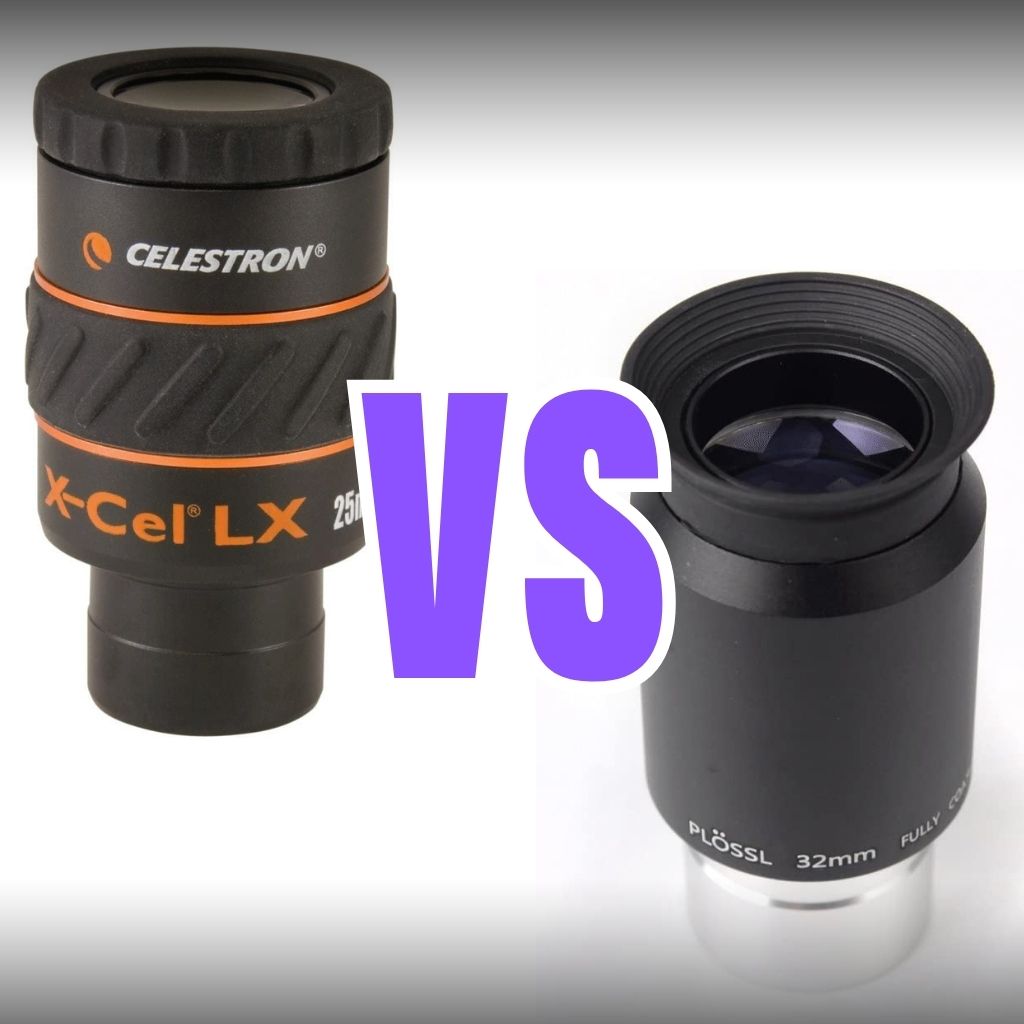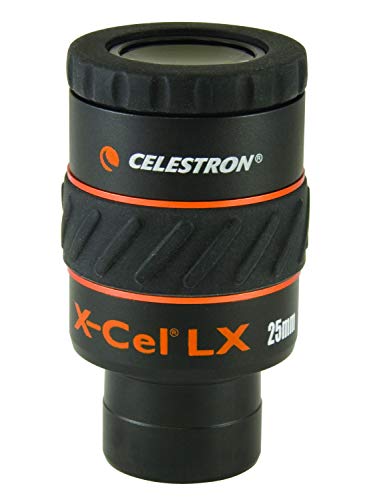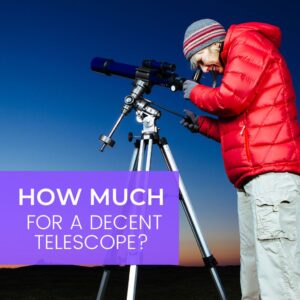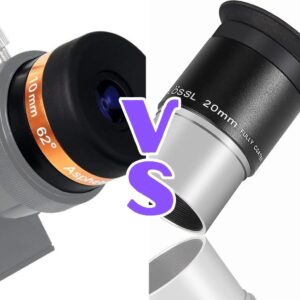This site contains affiliate links to products. I may receive a commission for purchases made through these links.
A 25mm eyepiece will offer a higher magnification and a narrower field of view, making it ideal for observing smaller deep-sky objects. On the other hand, a 32mm eyepiece will provide a wider field of view and lower magnification, making it suitable for observing larger deep-sky objects.
So, which one is right for you?
In this article, we’ll delve into the differences between these two eyepieces, explore their unique benefits, and help you determine which one is the best fit for your observing preferences.
How do I choose the right eyepiece for my telescope?
Choosing the right eyepiece for your telescope is crucial for getting the most out of your observing experience. There are several factors to consider. Here are some of them:
Telescope and eyepiece focal length/ magnification
The focal length of a telescope, combined with the focal length of an eyepiece, determines the magnification of the telescope. The higher the magnification, the closer and larger the object will appear.
However, higher magnification also means a narrower field of view, which can make it harder to find and track objects. It’s important to consider the maximum useful magnification of your telescope based on its aperture before selecting an eyepiece.
Using a 25mm eyepiece with a telescope with a focal length of 1000mm will yield a magnification of 40x while using a 32mm eyepiece will result in a magnification of 31.25x.
Higher magnification means a closer and larger object view but at the cost of a narrower field of view.
Eyepiece focal lengths are crucial for getting the most out of your telescope and achieving your observing goals.
Also, choose a finder eyepiece that matches your telescope’s specifications and provides a wide field of view to help you locate objects.
You may also like: Telescope Magnification: Beginners Guide W/ Examples
Telescope aperture
The aperture of a telescope determines how much light the telescope can gather and ultimately affects its resolving power.
A 25mm eyepiece can handle the telescope’s aperture without causing vignetting, while a 32mm eyepiece may cause vignetting, reducing the field of view.
Choosing the right eyepiece to match the telescope’s aperture is crucial for getting the best image quality.
You should also consider the exit pupil size and ensure it matches a particular telescope for optimal viewing.
You may also like: What Is a Good Aperture for a Telescope?
Focal ratio
The focal ratio, also known as the f-number, is the ratio of the telescope’s focal length to its aperture. It determines the brightness and sharpness of the image produced by the telescope.
A telescope with a fast focal ratio (i.e., a smaller f-number) will require eyepieces with shorter focal lengths to achieve higher magnifications.
Conversely, a telescope with a slower focal ratio (i.e., a larger f-number) will require eyepieces with longer focal lengths to achieve the same magnification.
The choice of eyepiece should therefore be made in consideration of the telescope’s focal ratio, as well as the desired magnification and field of view.
Field of view
The field of view of an eyepiece is the amount of sky visible through the eyepiece. A wider field of view makes it easier to find objects and track them as they move across the sky.
A 32mm eyepiece has a wider field of view than a 25mm eyepiece. However, a wider field of view also means less magnification.
Choosing an eyepiece with a suitable field of view for the object you want to observe is important.
Eye relief
Eye relief refers to the distance between the eyepiece and the observer’s eye. Longer eye relief is more comfortable, especially for eyeglass wearers, and allows for easier observation of objects for longer periods of time.
A 32mm eyepiece generally has a longer eye relief than a 25mm eyepiece, making it more comfortable for eyeglass wearers. However, longer eye relief can also reduce image quality.
Optical quality and coatings
An eyepiece’s optical quality can affect the image’s clarity, sharpness, and contrast. High-quality eyepieces often have multiple coatings that reduce reflections and improve light transmission.
Choosing an eyepiece with good optical quality and coatings is important to ensure the best viewing experience.
Budget and personal preferences
The cost of eyepieces can vary widely depending on their quality and features. It’s important to balance your budget with your needs and preferences when selecting an eyepiece.
Personal preferences, such as the type of objects you want to observe and the level of magnification you prefer, can also play a role in your choice of the eyepiece.
Is a 32mm eyepiece good for a telescope?
A 32mm eyepiece can provide a wide field of view, making it suitable for observing large objects such as star clusters and extended nebulae. However, it may not provide very high magnification. This can limit its usefulness for observing smaller objects.
But in general, the suitability of a 32mm eyepiece for a telescope depends on a few factors, such as the aperture and focal length of the telescope, as well as the observing conditions and personal preferences of the observer.
What can you see with a 32mm eyepiece?
With a 32mm eyepiece, you can see a wide range of celestial objects, including large star clusters, extended nebulae, and some galaxies.
You can also use it to observe the Moon and its surface features and larger planets such as Jupiter and Saturn.
However, you may need a higher magnification eyepiece for smaller planets such as Mars and Venus.
With that said, remember that getting a high-quality eyepiece to enhance your observing sessions is important.
Here are some 32mm eyepieces to consider:
Solomark 1.25″ 32mm Plossl Telescope Eyepiece
The SOLOMARK Plossl eyepiece with a 1.25″ 32mm diameter is designed for telescopes with standard 1.25-inch focusers and astronomy filters.
The eyepiece features a 4-element Plossl design, which provides better optical performance than K and H eyepieces, effectively reducing chromatic aberration and halo.
With an approximate 52-degree apparent field of view and a high-quality optical lens, this eyepiece minimizes internal reflection and maximizes contrast for clear and sharp images.
Celestron Omni Series 1-1/4 32MM Eyepiece
The Celestron Omni Series 1-1/4 32MM Eyepiece provides quality optics at a very affordable price. Its 4-element Plossl optical design produces clear, high-quality images.
The eyepiece features rubber eyecups that can be folded down or left up, providing comfort for eyeglass and non-eyeglass wearers while increasing the contrast.
The eyepiece’s beautiful matte aluminum barrels and blackened lens edges prevent internal reflections, ensuring you get the best image possible.
Orion 8828 32mm Q70 Wide-Field Telescope Eyepiece
The Orion 8828 32mm Q70 Wide-Field Telescope Eyepiece is a high-quality, super-wide angle 2″ eyepiece that offers sharp, high-contrast vistas at an unbeatable price.
Its 70-degree apparent field of view provides an immersive experience, while its five multi-coated lens elements made of high-index glass deliver clear and detailed images.
The eyepiece also offers luxurious eye relief and a parfocal design for comfortable and convenient viewing.
Is a 25mm eyepiece good for a telescope?
A 25mm eyepiece can be good for a telescope, depending on what you want to observe. It provides low magnification and a wider field of view, making it suitable for viewing larger objects.
However, the details and clarity of the object may not be as sharp as they would be with a higher magnification eyepiece.
What can you see with a 25mm eyepiece?
A 25mm eyepiece is ideal for observing star clusters, nebulas, and galaxies. It can also be used for moderate magnification views of the Moon, planets, and other celestial objects.
However, planets and the Moon may also appear smaller and less detailed with a 25mm eyepiece than a higher magnification eyepiece.
But in all, you need to use a high-quality eyepiece.
Here are some recommended 25mm eyepieces to consider for your telescope:
Celestron X-Cel LX Series 25mm eyepiece
The Celestron X-Cel LX Series 25mm eyepiece is specifically designed for planetary viewing, offering a wide 60° field of view through a six-element fully multi-coated lens system.
It comes equipped with pop-up rubber eyeguards for comfort and increased contrast, which can be easily raised or lowered with a twist.
The eyepiece also features a treaded rubber grip for a no-slip hold, even when wearing gloves.
Orion 8741 25mm Sirius Plossl Telescope Eyepiece
The Orion 8741 25mm Sirius Plossl Telescope Eyepiece is a 1.25″ eyepiece suitable for all types of telescopes, including reflectors, refractors, and catadioptrics like Maksutov-Cassegrains and Schmidt-Cassegrains.
It’s an excellent eyepiece for our solar system’s moderate-power observations of the Moon and planets.
The eyepiece provides sharp, bright views of many deep-sky objects, such as nebulae and star clusters.
It offers a 52-degree apparent field of view that produces clear, sharp images of celestial and terrestrial fare. The eyepiece is multi-coated to deliver high-contrast views with bright images.
SVBONY 25mm Telescope Lenses
The SVBONY Telescope Lenses 25mm Telescope Accessory has a fully-multicoated achromatic design, with two sets of four slices of multi-layer film gluing lens that eliminate chromatic aberration and increase lens permeability.
This results in bright and high-contrast views of celestial objects. The inside of the adapter is fully threaded to minimize reflections, while the blackened edges and interior reduce the scattering of stray light to maximize contrast.
With a 40-degree apparent field of view, this eyepiece is perfect for broad-field observations of the Moon, planets, medium-sized star clusters, a wide range of cloudy nebulas, and many deep space objects and deep-sky targets.
What are the differences between 25mm and 32mm eyepieces?
The main difference between a 25mm and a 32mm eyepiece is the field of view and magnification they provide. A 32mm eyepiece typically provides a wider field of view than a 25mm eyepiece, which means that you can observe larger areas of the night sky.
This can be useful for observing larger objects such as star clusters and galaxies.
However, the magnification provided by a 32mm eyepiece is typically lower than that provided by a 25mm eyepiece, which means that objects may appear smaller and less detailed.
In terms of design, both eyepieces may have similar optical designs, such as Plossl or wide-angle designs. However, the size of the eyepiece barrel may differ.
25mm vs 32mm eyepiece, which is better?
Let’s compare the 25mm and 32mm eyepieces to help you decide which one is better suited for your telescope and observing goals.
25mm eyepiece is better for viewing planets and lunar features than a 32mm eyepiece
A 25mm eyepiece is better suited for observing planets and lunar features because it provides higher magnification, which allows for more detail to be seen on these objects.
This can be especially useful for observing planetary features such as craters, mountains, and cloud bands.
A 25mm eyepiece can help to increase contrast on these objects, making it easier to see their features.
32mm eyepiece is better for observing large objects and deep-sky targets than a 25mm eyepiece
A 32mm eyepiece is better suited for observing larger objects such as star clusters, galaxies, and nebulas because it provides a wider field of view.
This can be useful for observing the overall shape and structure of these objects and finding them in the night sky.
It can provide a brighter and more immersive view of these objects, as it gathers more light than a smaller eyepiece.
25mm eyepiece provides a higher magnification than a 32mm eyepiece
A 25mm eyepiece provides a higher magnification than a 32mm eyepiece. This is because the same telescope will magnify more with a smaller focal length eyepiece.
If you have a small telescope or want to observe planets or other small objects in detail, a 25mm eyepiece might be better.
Another option is to use a Barlow lens. Barlow lenses are also versatile accessories that allow you to achieve higher magnification with any eyepiece in your collection.
32mm eyepiece provides a wider field of view than a 25mm eyepiece
A 32mm eyepiece provides a wider field of view than a 25mm eyepiece. This is because a longer focal length eyepiece will show more of the sky at once.
If you want to observe large objects like galaxies, nebulae, or star clusters, a 32mm eyepiece might be the better choice.
25mm eyepiece provides better eye relief than a 32mm eyepiece
A 25mm eyepiece typically provides better eye relief than a 32mm eyepiece. Eye relief is the distance between the eyepiece lens and your eye, and it’s important for comfort and ease of use.
If you wear glasses or prefer to observe with your glasses on, a 25mm eyepiece is great.
FAQs about telescope eyepiece
Below are answers to some frequently asked questions about telescope eyepieces:
What eyepiece is best for viewing galaxies?
When it comes to viewing galaxies, a low-magnification eyepiece with a wider field of view is usually preferred. This allows you to see the entirety of the galaxy and any surrounding nebulas or star clusters. Eyepieces with a longer focal length, such as 25mm or 32mm, are typically better suited for this type of viewing.
10mm vs 25mm eyepiece, which is more powerful?
The power of an eyepiece is determined by its focal length – the shorter the focal length, the higher the magnification. In this case, a 10mm eyepiece will provide more magnification than a 25mm eyepiece. However, higher magnification doesn’t always mean better viewing. The quality of the eyepiece and the conditions of the viewing environment can also play a role. It’s important to consider the type of objects you want to view and the conditions you’ll be viewing before deciding on an eyepiece.
Check out this article to read more on this: 10mm vs 25mm Eyepiece: Which One is Better for Your Telescope?
Takeaway: 25mm and 32mm eyepieces can help you achieve your observing goals
Choosing between a 25mm and a 32mm eyepiece depends on several factors, including the type of telescope you have, the objects you want to observe, and your personal preferences. While a 25mm eyepiece may be better for planetary viewing and offer higher magnification, a 32mm eyepiece may provide a wider field of view and be better suited for observing deep-sky objects.
It’s worth considering both options and experimenting to see which one works best for your needs.
Ultimately, the “better” eyepiece depends on your observing goals, the size of your telescope, and your personal preferences. Instead of using the same eyepiece, it’s often a good idea to have a few different eyepieces on hand so that you can switch between them as needed.
Alternatively, you can use Zoom eyepieces. Zoom eyepieces are a great option for stargazers who want to quickly and easily adjust their magnification without having to switch out eyepieces.
Investing in high-quality eyepieces from reputable brands can make a noticeable difference in the clarity and sharpness of your views.
You may also like:










